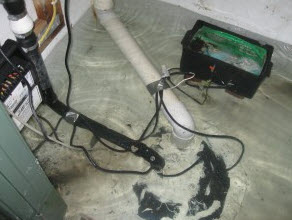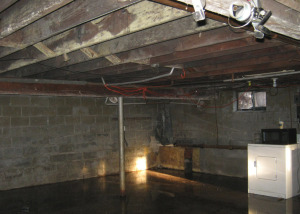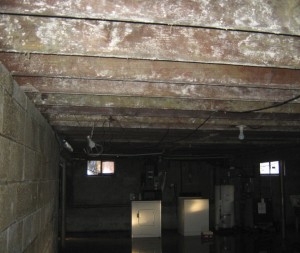[vc_row][vc_column][vc_column_text]
We’ve seen so many people in the last 3 weeks
affected with basement flood damage in the wake of rapidly warming temperatures, heavy rains, and snow melt.
[/vc_column_text][/vc_column][/vc_row][vc_row][vc_column width=”1/3″][vc_column_text]




[/vc_column_text][/vc_column][vc_column width=”2/3″][vc_column_text]Because the ground is still frozen outside, all that water has to go somewhere. And, because water takes the path of least resistance, that somewhere is usually right into your basement.
Over and over we’ve heard the words “this has never happened before.” And folks are left with a lot of worry along with the water that flooded their homes and businesses.
All these contribute to a highly toxic environment in an enclosed, dark space like a basement or crawlspace. And that’s the perfect breeding ground for viruses, bacteria, and mold.
How do you know if these buggies are present?
Your nose knows!
If you find yourself asking “what’s that smell?” then you know something’s growing.
If it smells like a locker room, most likely it’s bacteria; if it smells musty or cheesy, it’s most likely mold.[/vc_column_text][vc_column_text]
So what can people do to help themselves when they have a flooded basement – before the whole home becomes contaminated?
1. First, call your insurance agent! Then take pictures of the damage.
2. Next, get the water out. Don’t wait! Use a sump pump or trash pump to remove the standing water.
3. Third, use a wet/dry or shop vac to extract as much of the remaining water as possible.
4. Fourth, remove everything that is wet, including furniture, carpet, pad and drywall – up to 4 feet if necessary.
If there is insulation, throw that out too.
Insulation acts like a sponge and holds water for a very long time.
5. Then, spray everything with an anti-microbial solution. DO NOT USE BLEACH!
Bleach is mostly water and will feed mold on non-porous surfaces.
Go to Home Depot or Lowes and purchase a disinfecting solution that states clearly on the label that it does not contain bleach or ammonia. And there are many products now in the marketplace now that are non-toxic to humans and animals.
6. After you’ve extracted and sprayed antimicrobial, get a dehumidifier and as many fans as you can to circulate the air.
A dehumidifier by itself will only do part of the job.
Without air flow, sections of your flooded basement will remain wet – and grow health threatening mold and fungus.[/vc_column_text][/vc_column][/vc_row][vc_row][vc_column][vc_column_text]
And remember: professional remediation for flood water damage is always recommended because moisture mapping and monitoring are part of the service, along with photo-cataloging the damage and discarded items to help you with your insurance claim.
The professional water damage restoration experts at PuroClean Emergency Recovery Services have the equipment, technology, meters to measure the moisture, and the knowledge to dry your flooded basement or crawlspace efficiently – before mold and bacteria start to grow!
For Emergency Water Extraction and Flood Damage Restoration call 877-750-7876
[/vc_column_text][/vc_column][/vc_row][vc_row][vc_column][vc_column_text]
[/vc_column_text][/vc_column][/vc_row]
